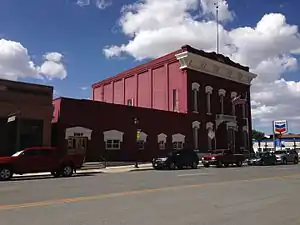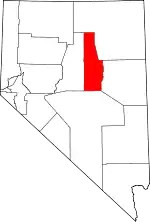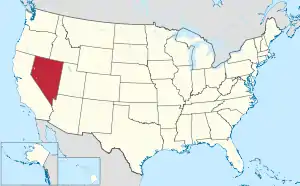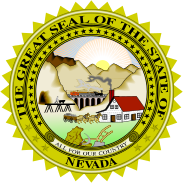Eureka County, Nevada
Eureka County is a county in the U.S. state of Nevada. As of the 2010 census, the population was 1,987,[1] making it the second-least populous county in Nevada. Its county seat is Eureka. [2]
Eureka County | |
|---|---|
| Eureka County | |
 | |
 Location within the U.S. state of Nevada | |
 Nevada's location within the U.S. | |
| Coordinates: 39°59′N 116°16′W | |
| Country | |
| State | |
| Founded | 1873 |
| Named for | Eureka |
| Seat | Eureka |
| Largest city | Eureka |
| Area | |
| • Total | 4,180 sq mi (10,800 km2) |
| • Land | 4,176 sq mi (10,820 km2) |
| • Water | 4.3 sq mi (11 km2) 0.1% |
| Population (2010) | |
| • Total | 1,987 |
| • Estimate (2019) | 2,029 |
| • Density | 0.48/sq mi (0.18/km2) |
| Time zone | UTC−8 (Pacific) |
| • Summer (DST) | UTC−7 (PDT) |
| Congressional district | 2nd |
| Website | co |
Eureka County is part of the Elko Micropolitan Statistical Area.
History
Eureka County was established in 1873 and formed from Lander County after silver was discovered more than 100 miles (160 km) east of Austin. The new mining camp's residents complained Austin was too far to go for county business and a new county was created. It was named for the ancient Greek term, Eureka, meaning, "I have found it."[3] This term was used earlier in California and other locations. Eureka has always been the county seat.
Geography

According to the U.S. Census Bureau, the county has an area of 4,180 square miles (10,800 km2), of which 4,176 square miles (10,820 km2) is land and 4.3 square miles (11 km2) (0.1%) is water.[4]
The county's highest point is the 10,631 ft (3240 m) summit of Diamond Peak in the Diamond Mountains along the border with White Pine County.[5]
Adjacent counties
- Elko County - northeast
- White Pine County - east
- Nye County - south
- Lander County - west
National protected area
Major highways
.svg.png.webp) Interstate 80
Interstate 80 U.S. Route 50
U.S. Route 50 State Route 278
State Route 278 State Route 306
State Route 306 State Route 766
State Route 766 State Route 781
State Route 781
Demographics
| Historical population | |||
|---|---|---|---|
| Census | Pop. | %± | |
| 1880 | 7,086 | — | |
| 1890 | 3,275 | −53.8% | |
| 1900 | 1,954 | −40.3% | |
| 1910 | 1,830 | −6.3% | |
| 1920 | 1,350 | −26.2% | |
| 1930 | 1,333 | −1.3% | |
| 1940 | 1,361 | 2.1% | |
| 1950 | 896 | −34.2% | |
| 1960 | 767 | −14.4% | |
| 1970 | 948 | 23.6% | |
| 1980 | 1,198 | 26.4% | |
| 1990 | 1,547 | 29.1% | |
| 2000 | 1,651 | 6.7% | |
| 2010 | 1,987 | 20.4% | |
| 2019 (est.) | 2,029 | [6] | 2.1% |
| U.S. Decennial Census[7] 1790-1960[8] 1900-1990[9] 1990-2000[10] 2010-2018[1] | |||
2000 census
At the 2000 census there were 1,651 people, 666 households, and 440 families living in the county. The population density was 0.39 people per square mile (0.15/km2). There were 1,025 housing units at an average density of 0.25 per square mile (0.09/km2).[11] Of the 666 households 33.00% had children under the age of 18 living with them, 56.50% were married couples living together, 5.00% had a female householder with no husband present, and 33.90% were non-families. 29.10% of households were one person and 9.90% were one person aged 65 or older. The average household size was 2.47 and the average family size was 3.08.
The age distribution was 27.80% under the age of 18, 5.20% from 18 to 24, 28.60% from 25 to 44, 25.90% from 45 to 64, and 12.40% 65 or older. The median age was 38 years. For every 100 females, there were 106.60 males. For every 100 females age 18 and over, there were 113.20 males.
The county's median household income was $41,417, and the median family income was $49,438. Males had a median income of $45,167 versus $25,000 for females. The county's per capita income was $18,629. 12.60% of the population and 8.90% of families were below the poverty line. Out of the people living in poverty, 11.70% are under the age of 18 and 16.40% are 65 or older.
2010 census
At the 2010 census, there were 1,987 people, 836 households, and 495 families living in the county.[12] The population density was 0.5 inhabitants per square mile (0.19/km2). There were 1,076 housing units at an average density of 0.3 per square mile (0.12/km2).[13] The racial makeup of the county was 89.3% white, 2.4% American Indian, 0.9% Asian, 0.1% black or African American, 5.1% from other races, and 2.2% from two or more races. Those of Hispanic or Latino origin made up 12.0% of the population.[12] In terms of ancestry, 43.3% were American, 14.8% were German, 11.4% were Irish, 7.3% were English, and 6.9% were Italian.[14]
Of the 836 households, 27.3% had children under the age of 18 living with them, 51.6% were married couples living together, 4.2% had a female householder with no husband present, 40.8% were non-families, and 33.0% of households were made up of individuals. The average household size was 2.38 and the average family size was 3.07. The median age was 42.4 years.[12]
The median household income was $61,400 and the median family income was $75,179. Males had a median income of $54,625 versus $42,321 for females. The per capita income for the county was $30,306. About 9.9% of families and 16.2% of the population were below the poverty line, including 23.6% of those under age 18 and 13.9% of those age 65 or over.[15]
Communities
There are no incorporated places in Eureka County.
Census-designated places
- Crescent Valley
- Eureka (county seat)
Politics
Background
Eureka County is heavily Republican. This does not, however, have a large effect on elections in the state due to the fact that the majority of Nevada's population lives in Clark County and Washoe County.
Summary Of Political Climate
Eureka County is strongly Republican, The last time they voted for a Democratic candidate was in 1964, and the last time a Democratic candidate recorded a quarter of the county's vote was in 1988. The last time a Republican candidate didn't record a majority of the county's vote was in 1992, when the vote was somewhat split when independent candidate Ross Perot recorded approximately a third of the county's vote. In 2016, Democratic candidate Hillary Clinton received only 8.67% of the vote.
| Year | Republican | Democratic | Third parties |
|---|---|---|---|
| 2020 | 88% 895 | 10.3% 105 | 1.7% 15 |
| 2016 | 84.7% 723 | 8.7% 74 | 6.7% 57 |
| 2012 | 82.1% 663 | 13.2% 107 | 4.7% 38 |
| 2008 | 75.7% 564 | 19.3% 144 | 5.0% 37 |
| 2004 | 77.4% 571 | 19.5% 144 | 3.1% 23 |
| 2000 | 75.5% 632 | 17.9% 150 | 6.6% 55 |
| 1996 | 59.9% 412 | 23.0% 158 | 17.2% 118 |
| 1992 | 47.8% 330 | 18.7% 129 | 33.5% 231 |
| 1988 | 71.0% 413 | 26.0% 151 | 3.1% 18 |
| 1984 | 76.0% 439 | 21.5% 124 | 2.6% 15 |
| 1980 | 76.2% 430 | 18.3% 103 | 5.5% 31 |
| 1976 | 58.2% 272 | 34.9% 163 | 6.9% 32 |
| 1972 | 72.8% 371 | 27.3% 139 | |
| 1968 | 56.5% 277 | 30.4% 149 | 13.1% 64 |
| 1964 | 46.0% 243 | 54.0% 285 | |
| 1960 | 51.7% 239 | 48.3% 223 | |
| 1956 | 64.3% 330 | 35.7% 183 | |
| 1952 | 70.7% 379 | 29.3% 157 | |
| 1948 | 51.7% 312 | 46.1% 278 | 2.2% 13 |
| 1944 | 59.4% 317 | 40.6% 217 | |
| 1940 | 44.6% 284 | 55.4% 353 | |
| 1936 | 31.3% 180 | 68.8% 396 | |
| 1932 | 26.1% 136 | 73.9% 385 | |
| 1928 | 49.0% 251 | 51.0% 261 | |
| 1924 | 50.0% 209 | 22.5% 94 | 27.5% 115 |
| 1920 | 63.8% 313 | 32.0% 157 | 4.3% 21 |
| 1916 | 46.0% 239 | 50.6% 263 | 3.5% 18 |
| 1912 | 16.5% 70 | 49.3% 209 | 34.2% 145 |
| 1908 | 46.6% 224 | 45.3% 218 | 8.1% 39 |
| 1904 | 62.5% 235 | 28.5% 107 | 9.0% 34 |
References
- "State & County QuickFacts". United States Census Bureau. Archived from the original on June 6, 2011. Retrieved September 23, 2013.
- "County Explorer". National Association of Counties. Retrieved June 7, 2011.
- Gannett, Henry (1905). The Origin of Certain Place Names in the United States. Govt. Print. Off. p. 122. Retrieved January 1, 2016.
- "2010 Census Gazetteer Files". United States Census Bureau. August 22, 2012. Retrieved December 20, 2014.
- "Diamond Peak, Nevada". Peakbagger.com. Retrieved October 6, 2014.
- "Population and Housing Unit Estimates". Retrieved May 18, 2019.
- "U.S. Decennial Census". United States Census Bureau. Retrieved December 20, 2014.
- "Historical Census Browser". University of Virginia Library. Retrieved December 20, 2014.
- "Population of Counties by Decennial Census: 1900 to 1990". United States Census Bureau. Retrieved December 20, 2014.
- "Census 2000 PHC-T-4. Ranking Tables for Counties: 1990 and 2000" (PDF). United States Census Bureau. Retrieved December 20, 2014.
- "U.S. Census website". United States Census Bureau. Retrieved January 31, 2008.
- "DP-1 Profile of General Population and Housing Characteristics: 2010 Demographic Profile Data". United States Census Bureau. Archived from the original on 2020-02-13. Retrieved 2016-01-21.
- "Population, Housing Units, Area, and Density: 2010 - County". United States Census Bureau. Archived from the original on 2020-02-13. Retrieved 2016-01-21.
- "DP02 SELECTED SOCIAL CHARACTERISTICS IN THE UNITED STATES – 2006-2010 American Community Survey 5-Year Estimates". United States Census Bureau. Archived from the original on 2020-02-13. Retrieved 2016-01-21.
- "DP03 SELECTED ECONOMIC CHARACTERISTICS – 2006-2010 American Community Survey 5-Year Estimates". United States Census Bureau. Archived from the original on 2020-02-13. Retrieved 2016-01-21.
- Leip, David. "Dave Leip's Atlas of U.S. Presidential Elections". uselectionatlas.org. Retrieved 2018-04-12.
